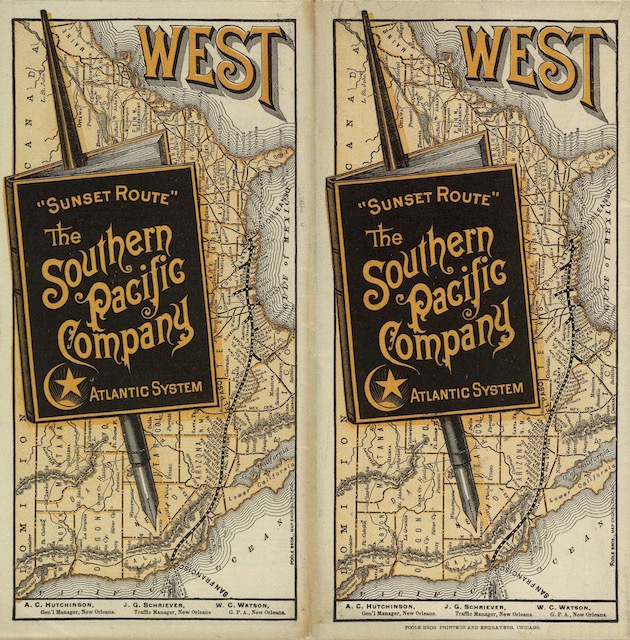Today’s timetable is peculiar in several ways. Like several we have seen before, it mainly has westbound schedules, probably because its goal is to entice people to emigrate west. (It does have one very brief eastbound schedule.) Also like several we have seen before, it repeats the schedule of SP trains several times, eight to be precise, each one showing a different combination of connections emigrants could make from Boston or New York to New Orleans, the beginning of SP’s westbound rails.
 Click image to download a 17.9-MB PDF of this timetable, which is from the David Rumsey map collection.
Click image to download a 17.9-MB PDF of this timetable, which is from the David Rumsey map collection.
Other peculiarities are unique to this timetable. The cover says this is for the SP’s “Atlantic System,” as opposed to the “Pacific System.” One panel of the brochure indicates that the Atlantic System consisted of Louisiana and Texas (though neither were on the Atlantic Ocean). The timetable includes condensed schedules of the Houston & Texas Central, an SP subsidiary in Texas.
If this is for the Atlantic System, however, why does the timetable include the schedule between San Francisco and Portland? That route wasn’t even completed in 1884: people could take a Southern Pacific train from Oakland only as far as Gibson, California, which was 100 miles short of Ashland, Oregon. From Ashland, the Oregon & California Railroad offered a train to Portland. Between Gibson and Ashland travelers had to take a stagecoach, which took almost 24 hours, probably because it spent the night in Yreka, making the entire trip to almost three days long. A steamship from San Francisco to Portland would have been faster, but the timetable notes that it only went once a week.
The brochure also has schedules for trains from San Francisco and Los Angeles to California resorts such as Lake Tahoe, Santa Cruz, Santa Monica, and Yosemite. But there is absolutely no mention, other than a line on the map, of SP’s route from Sacramento to Ogden.
Even more peculiar is the absence of any mention, other than dotted lines on the map, of Southern Pacific’s steamship services between New Orleans and New York and between New Orleans and Tampa, which were designed to compete with rail routes. The New York-New Orleans steamship was probably faster and likely more comfortable than any of the rail routes described in the timetables, many of which went over three or four railroads (each requiring a change of trains) between New York and New Orleans. The only reason I can think of for why SP didn’t mention the steamship route is that it was priced too high for potential emigrants, but that doesn’t make much sense.
Finally, it is worth noting that the eight different repeats of the timetable for Southern Pacific west of New Orleans show that SP ran just one train a day on this route in 1884. The train was not yet called the Sunset Limited but the route was called the Sunset Route.
The train left New Orleans at 7:30 pm, arriving in Los Angeles four days later at 12:50 pm, for a trip of just under 92 hours at an average speed of just under 22 mph. The return train left Los Angeles at 2:00 pm and arrived in New Orleans four days later at 4:00 pm, for a trip of exactly 96 hours and an average speed of 21 mph. Like the early Sunset Limited, the train continued to and from San Francisco at similar average speeds.
